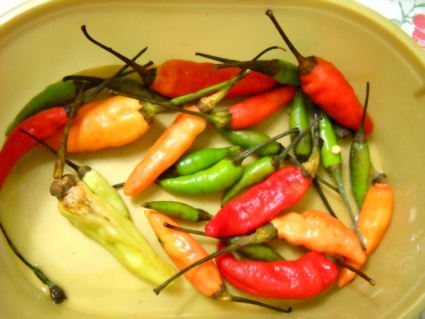March 6, 2014
Hot spicy food a must for hot countries?

It may seem ironic that most of the spiciest foods in the world originated in a band close to the equator, in the hottest regions of the world.
India, for instance, has at least fifty extremely hot peppers. But hot food actually cools the body. Capsaicin, the chemical in spicy foods that makes them hot, increases circulation, which in turn brings more hot blood from the core of the body to the skin's surface, while at the same time dilating capillaries in the skin.
These two factors cause sweating, an important way the body counters overheating. The skin may get hot, but the heat that the blood brings to the surface is radiated out and away from the body. The net effect is that the core temperature of your body is more easily stabilized.
In general, hot, spicy foods are stimulants. They stimulate the circulation and raise body temperature. If you are living in a hot climate, the increase in body temperature can make you feel cooler by diminishing the difference between you and the surrounding air and by inducing sweating, which cools the body when the perspiration evaporates. This may help explain why tourists, not used to the local hot food, often sweat more than the local people who are accustomed to hot food.
The impact of hot sauce on body temperature -- and hence, overall metabolic rate -- has a specific intensity and duration. According to a Penn State research study, eating foods spiced with hot sauce can increase your body's metabolic rate by up to 20 percent. This increase in your body's metabolism can last for as many as 30 minutes, making spicy meals a viable option for temporarily speeding up your metabolism.
Spicy foods not only boost your metabolism and increase body temperature. Researchers found that rats following a high-fat diet with capsaicin experienced more reductions in body fat than rats fed a high-fat diet without capsaicin, according to scientists at Daegu University in Korea.
Researchers found that capsaicin increases the production of proteins inside fat cells that help break down fat, thereby reducing the size of fat cells. Moreover, capsaicin significantly reduced the synthesis of new fat cells, according to research reported in the April 2010 issue of the "Journal of Proteome Research." However, further research on humans is necessary.
Research studies also indicate that capsaicin may reduce high blood pressure, which forces your heart to work harder to pump blood through your body and damages blood vessels that supply nutrients to your organs. This in turn, increases your risk for a variety of illnesses.
Researchers at the Third Military Medical University in China discovered that capsaicin increases the production of nitric oxide, a gas molecule that lowers blood pressure by dilating blood vessels and improving blood flow. The findings were published in the August 2010 issue of "Cell Metabolism."
Hot chili peppers may also lower blood sugar levels, and thus help reduce chances of getting diabetes, according to scientists at Mahidol University in Thailand, who investigated the effects of chili pepper on plasma glucose levels and metabolic rate in healthy Thai women. Subjects were assigned a glucose drink with or without five grams of chili pepper. Scientists observed that those in the chili pepper group had significantly lower blood glucose levels 30 minutes after ingestion compared with those who didn’t have chili pepper. The findings were reported in the September 2003 issue of "Journal of the Medical Association of Thailand.”
Interestingly, capsaicin is often also used as the active ingredient in certain ointments for aching muscles due to the "heat" it produces. Although hot sauces often contain many other, non-spicy ingredients such as vinegar, salt and seasonings, it is the capsaicin content of the "active ingredients" in hot sauce -- spicy peppers -- that causes a temporary increase in body temperature and metabolism.
Peppery hot foods have been a part of the human diet for more than 8,000 years. Long before the ancient Greeks and Romans gave monetary value to peppercorns (they were used to pay fines, rent and taxes and to buy and free slaves), the South American Indians were eating fiery hot wild chilies. Chilies were eaten in Mexico, Brazil and Peru 6,000 years before the birth of Christ and were one of the first domesticated plants in the New World.








